Review : Apple MacBook Apple 2.0GHz MacBook MB061ZP /A
Review : Apple MacBook Apple 2.0GHz MacBook MB061ZP /A
“The Intel-based MacBook surpassed every expectation that I had. I am duly impressed!.”
Introduction
Just when you thought it was safe to buy a new MacBook Pro, Apple unleashes a product that is possibly one of the company's best, fastest and least expensive portable systems ever.
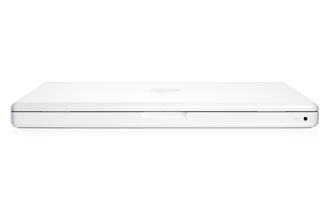

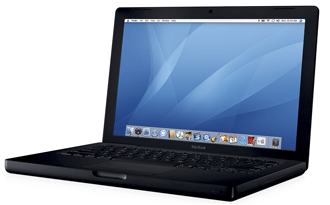
The MacBook replaces a long, proud line of iBook laptops that have traditionally served students and consumer-level Mac users; the iBook being the ideal budget portable that upheld the integrity of Apple's hardware and software architectures. And though it is a direct replacement of the well-loved and iconic iBook and an indirect replacement of the 12" G4 PowerBook, the MacBook effectively defies its own ancestry and surpasses all anticipated performance levels for a sub-14" laptop. It has even outclassed the MacBook Pro on more than one occasion.
Best of all, the MacBook is one of the most affordable high-performance laptops on the market today.
Features and Design
The first and most obvious design feature of the MacBook is that it comes in two colors - white and black. Internally, the white and black MacBooks are exactly the same. The only non-customizable difference between the black and white MacBooks is a $200 premium for the black encasing.
As a matter of genealogy, the white MacBook has the same basic design features as the iBook - glossy white body, standard FireWire, USB 2.0, Ethernet, external video and audio ports. Apple has removed ye olde dial-up modem and carrier-pigeon ports from its newest line of portable and desktop computers and in doing so, has ordered us to wake up and smell the broadband. While the MacBook Pro comes with an ExpressCard/34 slot (an upgrade from the PCMCIA slot in PowerBooks), the MacBook does not. The iBook never had a PCMCIA card slot, nor did the 13.3" PowerBook, so not too many people are losing sleep over the absence of an ExpressCard slot.
A major improvement added to the MacBook is the built-in iSight camera. I can't even count the number of times I 'almost' bought a bulky stand-alone iSight camera for my travels. Now my panic is over and I can video chat with my wife and family while on the road.
Apple designed the MacBook with a very quiet 4X SuperDrive (or Combo drive on the base model). This is the exact same SuperDrive being installed in current MacBook Pros. Even though the SuperDrive is only 4X, it burns CDs and DVDs quickly and stably. The 4X SuperDrive can read dual-layer DVDs, but it can only burn single layer disks.
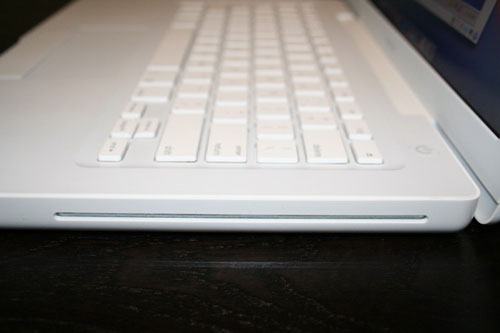
The MacBook SuperDrive
The MagSafe power connector was recently introduced to the world when it was added to the MacBook Pro. As I mentioned in an earlier review, the MagSafe is one of the best little innovations added to the MacBook (and MacBook Pro) line. Standard power adapters on laptops plug into the side of the laptop body and are intended to fit tightly so they do not fall out. The downside to this tight male-female fit is the fact that when someone inevitably trips over the power cord, the tip of the power cord and the power-supply's connection to the logicboard can be damaged. Many laptops have been sent flying to the floor from tables, desks and counter tops. MagSafe successfully cures "Airborne Mac Syndrome" by using magnetic attraction and surface-to-surface electric conductivity - simple, yet brilliant. A small array of magnets holds the tip of the power adapter to the charging port on the MacBook Pro. While connected, electricity flows and charges the battery. Tripping over the power cord (or simply unplugging it from any angle) harmlessly disconnects the MagSafe from the MacBook Pro. No more Airborne Mac Syndrome, no more internal or external damage, no more tears.
A slightly disappointing remnant carried over from the iBook line is the coin-slot battery bay. An unknown genius at Apple developed a new slide-release battery bay for the MacBook Pro, replacing the damage prone and annoying coin-slot battery release on earlier PowerBooks. Sadly, this wonderful feature was left off the MacBook.
Setup and Use
System as Tested
· 2.0GHz Intel Core 2 Duo
· 13.3-inch widescreen display
· 1GB memory (2x512mb SODIMMs)
· 80 GB 5400-rpm Serial ATA hard drive
· COMBO DRIVE
· Intel GMA 950 GPU with 64MB of DDR2 SDRAM
· Built-in AirPort Extreme and Bluetooth 2.0
· Apple Remote
Setting up the MacBook was quick and easy. The box comes with the MacBook, power supply, Front Row remote and OS X restore DVDs. I had everything set up on my desk in less than a minute.
I used my trusty timer and count-down app, Chimoo Timer to time the setup process.
Timer started and power button pressed, the 'select language' screen appeared in 45 seconds, as opposed to 1 minute 53 seconds with my MacBook Pro. My full name, address and other registration information were entered by 2 mins 49 seconds. On the MacBook, OS X was set up and running by the time 4 mins 20 seconds elapsed - as opposed to 6 mins 05 seconds for my MacBook Pro setup. Based on these numbers, the MacBook ran setup approximately 39% faster than the MacBook Pro.
Address Book, iCal, Safari, Firefox, Mail, Thunderbird, iChat and Adium all opened in less than 1.5 seconds. iPhoto opened in 1.7 seconds. Importing 500 8-megapixel images into iPhoto took an impressive 4 minutes 30 seconds. iWork apps, Pages and Keynote, opened in less than 5 seconds. Rosetta-dependent applications like Word, Acrobat Professional and Photoshop CS2 open much slower than Universal applications, but they open faster on the MacBook than they do on a G4 PowerBook.
Apple seems to be on a roll when it comes to improving battery life. The MacBook gets the best battery life of any past or present Apple portable. With "Better Energy Savings" option selected and the screen brightness turned down half way (which is still much brighter than iBooks set at max brightness), I was able to stretch my battery life well over 5 hours while working on iWork projects, surfing the Internet and occasionally chatting with friends. The MacBook, it would seem, can hold up to use on cross country flights, long classes or lectures, etc.
Our Offer for this site readers :
Instant Discounts and Specials on thousands of mobile replacement batteries, ac adapters, dc adapters, and more!
The keyboard on the MacBook has a new design - instead of being a replaceable and removable part like on the iBook, this keyboard is built into the frame of the MacBook. It is somewhat inset, keeping the keys from touching the LCD screen when the lid is closed. The keys are spaced properly and the typing action is very smooth and responsive. Some keyboards feel loose and wobbly, whereas this new keyboard style feels solid and reliable. One major bonus - the built-in keyboard makes it much harder to get potato chip fragments under the keys.
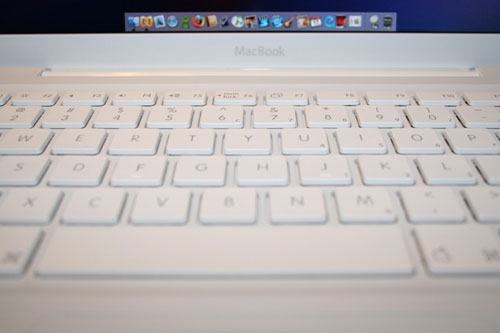
The Keyboard on the MacBook
The screen on the MacBook is very bright and clean. I compared the MacBook's screen brightness to the iMac G5, Intel iMac and MacBook Pro and found the MacBook equal in quality. The 1280x800 resolution screen is powered by the Intel Graphics Media Accelerator 950 with 64MB of shared DDR2 memory. Similar to the Intel Mac mini Core Duo, the integrated graphics chip is very impressive but not flawless. It is perfect for all basic applications like iPhoto, iMovie HD and even Photoshop. One caveat - based on numerous reports on the Internet, the MacBook's GPU may not be suitable for hardcore gaming.
In my review of the MacBook Pro, I used the DVD movie Underworld to test the ATI Mobility Radeon X1600 video card. I discovered that the MacBook Pro's DVD playback was simply perfect. When testing Underworld on the MacBook, I noticed some slight artifacts in dark, high-action scenes common to the movie. These artifacts were not distracting at all, but they were present. On a positive note, the colors in Underworld, Last Samurai and Crash were much more life-like thanks to the glossy screen. Overall, I think the integrated graphics card does a fantastic job.
Traditionally, iBooks, PowerBooks and even the first few revisions of the MacBook Pro came with standard matte LCD screens. When speculation about the MacBook began, no one would have guessed that Apple would introduce full-gloss screens for future laptop lines. While many people welcomed the glossy screens with enthusiasm, some designers, photographers and video professionals suggested that the glossy nature of the LCD screens would violate the sanctity of true-color rendering. Apparently, the glossy screen makes colors look more vivid, rich and saturated. Because of this effect, they say, native colors are not accurately represented. I found the more vivid and saturated colors quite pleasing.
I opened iPhoto and displayed a set of images on the MacBook's glossy screen and on the matte screen of an iMac G5. The colors, in my estimation, were almost identical. My attention, however, kept going back to the MacBook. It just looks better. I found that the glossy screen creates a slightly reflective surface, however I did not find it distracting in the least bit. In fact, at most angles, the glossy MacBook screen is easier to use outside than the matte screens on other laptops.
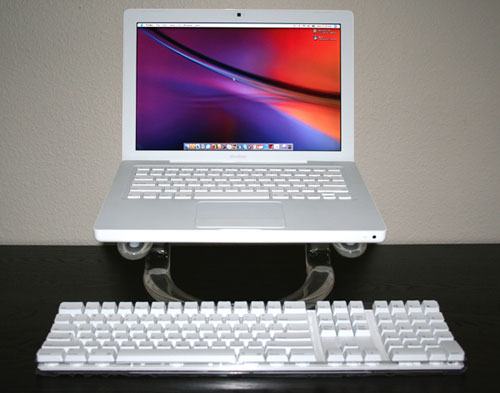
The MacBook Setup in a Desktop Configuration
Hot or Not? - Part Deux
In my review of the MacBook Pro, I noted that the MacBook Pro was become notorious for running hot - some recorded skin-reddening external temps of over 120 degrees F. Apple Customer Relations reps have acknowledged that this temperature issue is likely due to an over-application of thermal grease on the heat syncs for the dual-core processor, graphics processor and Northbridge.
The MacBook also runs hot, but not in the same way as the MacBook Pro. Specifically, the internal temperatures of my MacBook Pro averaged 140 degrees F and the external temperatures reached 123 degrees F. The MacBook, however, runs much hotter internally - 150-192 degrees F - whereas the external temps stay near 90 degrees F. Because of an external temperature reduction of nearly 30 degrees F, I've found that I am much more comfortable using the MacBook.
Memory is the Crucial Component
The base configuration of the MacBook line comes with 512MB of 667MHz DDR2 SDRAM (PC2-5300) on two chips, 256MB each. This complement of 512MB RAM is just enough to let the MacBook function well, but not to its full potential. Running a MacBook on 512MB RAM is like placing a Datsun engine in a Porsche. It'll go, but don't be surprised that it does zero-to-60mph in 4.6 minutes. Most, if not all MacBooks on display in Apple stores are set up with 1GB RAM. Some unsuspecting MacBook buyers test the display units and find themselves impressed and enamored. When they bring their minimal-config systems home, they discover major reductions in performance, or worse yet - never discover just how fast the MacBook can be!
The MacBook used for this review was originally (and intentionally) a base-config unit with 512MB RAM. To boost things into warp drive, I installed 2GB of Crucial memory (Crucial part #CT541623) as recommended by the Crucial Memory Advisor. With 2GB of memory installed, the MacBook was faster than any laptop I had ever used, including my MacBook Pro. It was this 2GB RAM config that I used for this review.
Installing 1GB of RAM is sufficient to let the MacBook operate at comfortable speeds - much like like driving 55 on the highway and never putting the pedal to the metal. Maxing the RAM out to 2GB is excellent advice for people who'll be using memory intensive applications like iMovie HD, Photoshop and Parallels Workstation for running multiple operating systems which, incidentally, can use from 300MB to 800MB RAM instantly. Incidentally, if you are concerned about the integrated graphics card using 64MB to 80MB of system memory, installing 2GB RAM will ease any worries you may have about system performance being negatively effected. With 2GB RAM installed, my MacBook seems to perform as well as my MacBook Pro.

Image Courtesy of Apple
Conclusion
I've owned and used many Apple computers, both PowerPC and Intel-based. I am a terribly finicky user and it takes a lot to impress me. It is even harder to get me to dote over a product like a proud parent, but I can say without a doubt that the MacBook is absolutely my favorite laptop ever.
The MacBook is ideal in so many ways. It is light, slim, fast and capable of so much computing power that I find myself NOT wondering when I should trade up. The physical design is impressive and ergonomically wonderful. The screen is beautiful and delivers sharp, vibrant and life-like images. The keyboard is a pleasure to use. The internal architecture, except for GPU, is nearly identical to the MacBook Pro, which means that it is as fast a computer as the much more expensive Pro variant.
The Intel-based MacBook surpassed every expectation that I had. I am duly impressed!
Pros:
- Very inexpensive
- Light weight
- Near silent
- Exceptional battery life
- Super-bright screen
- iSight camera built-in
Cons:
- Built-in speakers could be a little louder
Source: digitaltrends